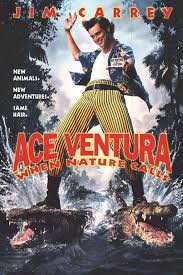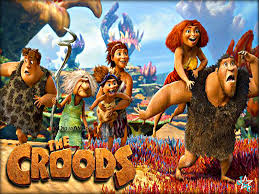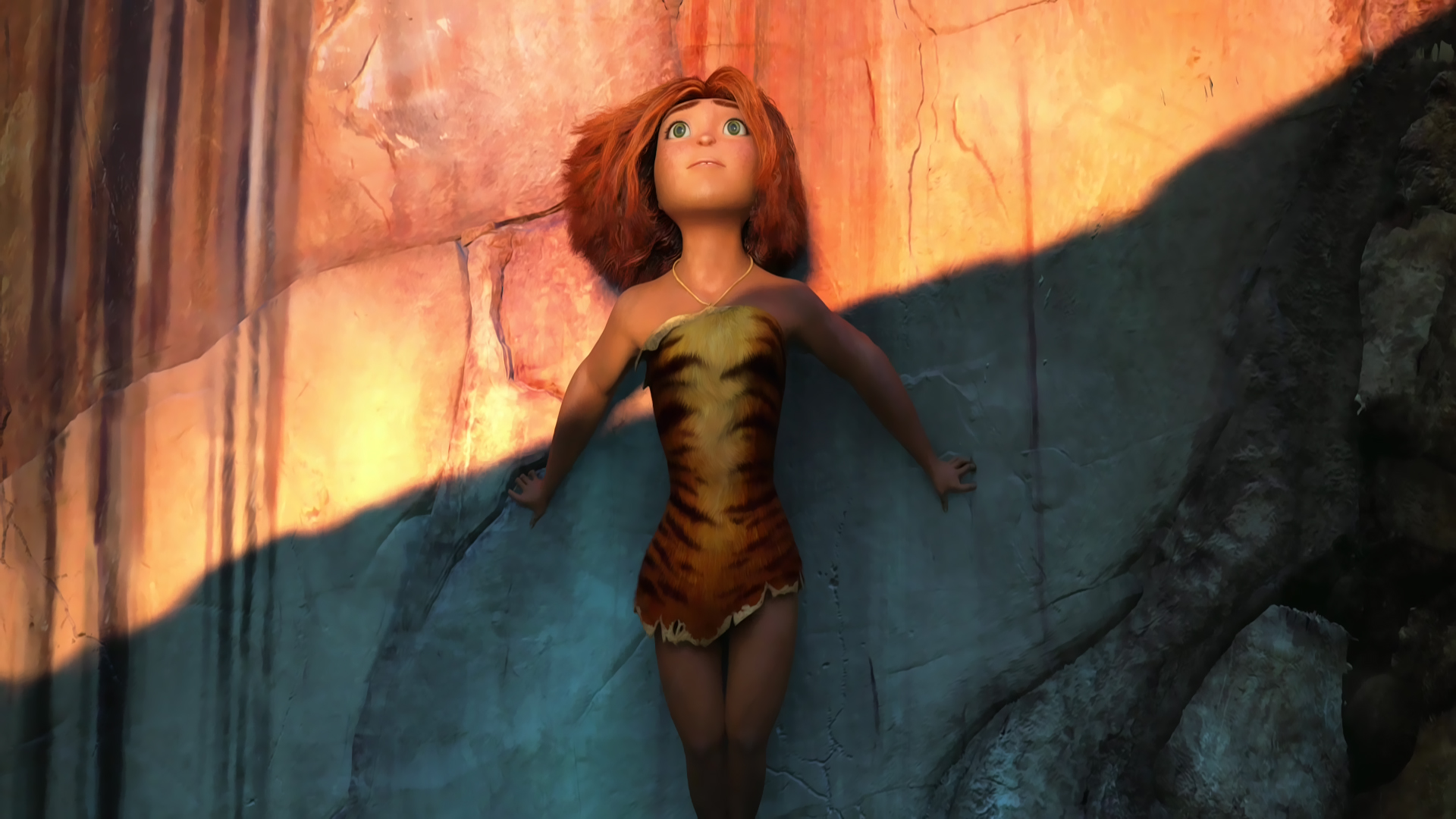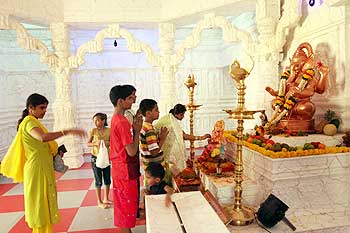There are movies that make you forget everything, including work. And then there are movies that remind you of work. Here are some which remind me of Qualitative Research:
1. Ace Venture - The story of a pet-detective starring Funny-Face Jim Carrey. In one of the sequences, he has to find the owner of a particular type of ring. He sets out with a list of people who have similar rings and needs to check each one of them without letting them know. See video here. To me, it is a wonderful way of doing Ethnographic Immersions - where
- you spend time with the respondent
- you become part of their environment
- customize your approach to personality of respondent; even trains self to be able to do that
- have specific information requirements and spend only as much time as required for it

Apart from that, he also uses techniques to go back to a person's childhood to understand his guilt and intentions.
In the same movie, he is shown doing 'secondary research' and is shown reading newspaper clippings on what seems to be the internet.
2. The Croods - This animated movie about a cave family shows different mind-sets for research.

The first is Grug Crood, the father. He is an over-protective head of his family and wants everyone to 'stay within the boundaries'. He is afraid of the unknown and evades any chance of having to encounter anything that is not familiar. If he was in research, he would have been a quantitative researcher working on the same tools with the same techniques, getting uncomfortable with anything outside the template and enjoys working in silos.

Then there is Eep Crood, the daughter who seeks adventure, wants to see the unseen, know the unknown and explore the world beyond the boundaries set by her father. At times, her curiosity gets her into trouble, but she seeks adventure even in that. If in MR, she would be a lively, curious and hard-working qualitative researcher.

And then, there is Guy. He is bold, adventurous and uses innovative thinking to explore life around him. He has no defined boundaries and is creative enough to use anything around him as a tool to achieve his purpose. If in research, he would be someone who can transcend different functions, adapt to different situations and be a driver of innovation.

In the story, Guy opens up a new world for the Croods...much beyond Grug's boundaries. It's an under-rated movie and definitely worth a watch!
3. Ek Ruka Hua Faisla - Adapted from the original, 12 Angry Men, this movie is about a group of 12 men who have been appointed as a jury by the court of law. They are gathered in a room and need to deliberate whether the accused is really guilty of killing his father or not. While most are convinced with the evidence presented in court, there is one man who feels that the matter deserves more thought and investigation. Through the story, he presents perspectives and points of view that force the others to think differently, and by the end, he manages to convince everyone else.
Why it makes me think of research? Yes, because it is a group setting, for sure but not just that.

There is dearth of time. Until there is purpose.
All other men in the room had a reason to be elsewhere. They wanted to give their views and run away to do more important things. But our man gave them a sense of purpose - to prevent a wrong decision from spoiling a boy's life, for ever.
Similarly, in a FGD, it helps establish the significance of the discussion to ensure that participants are serious and share some dedication to our objective.
Pull the right chords
However homogeneous a group, there could be all kinds of people and personalities to deal with. Each will have a chord, which when pulled, let's them sing their emotions. In the movie, the protagonist finds arguments appropriate to individuals, which helps convince them.
In a research set-up, it may be difficult to pull chords of all respondents, but it helps to identify and pluck a couple of them. It is best to allow them to express themselves and wait for the right emotion that will resonate the most.

There will always be overpowering persona. And a deeper reason.
The character played by Pankaj Kapur is a loud, arrogant and aggressive businessman who runs down people who go against his view. He tries hard to 'convert' people back on his side of declaring the boy guilty. Though he does not have anything personal against the boy he does not want the boy to go unpunished. It is only when our man provokes him does he lead to a hidden agenda coming from a dark secret - which makes him despise such a 'bad son'.

Whatever makes them think
When he had to convince others of his visualization of the crime scene, our man makes props and recreates the scene to demonstrate what he meant. He leaves no stones unturned and brings forth enough and more evidence, doubt and possibilities that helps them think differently.
I wish our stimuli could do that all the time.

Apart from these, there are lots of lessons for moderation and on how to bring the focus in Focus Groups.
4. Sherlock Holmes - Ofcourse the movie is brilliant, just like numerous TV series, books and stories. But what i associate most with a researcher are his excellent observation skills, his reliance on data, his wisdom not take facts at face value and the persistent quest for truth.

There are lots of cases, scenes and dialogues from all work around this fictional character. Here are some which mean something to a researcher:
I don't think it is fair to classify him as a specific type of researcher except for 'the ideal one'.
5. Judaai - This Hindi movie had a character played by Paresh Rawal who sports a question mark as his hairstyle, goes around asking random, unrelated and irrelevant questions. His barrage of irritating and unreasonable queries repels people. Those who due have the misfortune to be subject to his enquiry end up dizzying to the ground.

Here are some (most enjoyable if you understand Hindi):
http://www.youtube.com/watch?v=5THYOZaVaFY
http://www.youtube.com/watch?v=fORf2Z8GHvU
The connection with research if a lot more obvious here. The kind of questions we ask - whether they are connected, have a logical flow, appear relevant and asked in a way that doesn't stress respondents. If research begins to repel people, we won't have people to converse with.
I don't know what to call this breed.
So, well...this is it. Watch out for researchers in the next movie you see!
1. Ace Venture - The story of a pet-detective starring Funny-Face Jim Carrey. In one of the sequences, he has to find the owner of a particular type of ring. He sets out with a list of people who have similar rings and needs to check each one of them without letting them know. See video here. To me, it is a wonderful way of doing Ethnographic Immersions - where
- you spend time with the respondent
- you become part of their environment
- customize your approach to personality of respondent; even trains self to be able to do that
- have specific information requirements and spend only as much time as required for it
Apart from that, he also uses techniques to go back to a person's childhood to understand his guilt and intentions.
In the same movie, he is shown doing 'secondary research' and is shown reading newspaper clippings on what seems to be the internet.
2. The Croods - This animated movie about a cave family shows different mind-sets for research.
The first is Grug Crood, the father. He is an over-protective head of his family and wants everyone to 'stay within the boundaries'. He is afraid of the unknown and evades any chance of having to encounter anything that is not familiar. If he was in research, he would have been a quantitative researcher working on the same tools with the same techniques, getting uncomfortable with anything outside the template and enjoys working in silos.

Then there is Eep Crood, the daughter who seeks adventure, wants to see the unseen, know the unknown and explore the world beyond the boundaries set by her father. At times, her curiosity gets her into trouble, but she seeks adventure even in that. If in MR, she would be a lively, curious and hard-working qualitative researcher.

And then, there is Guy. He is bold, adventurous and uses innovative thinking to explore life around him. He has no defined boundaries and is creative enough to use anything around him as a tool to achieve his purpose. If in research, he would be someone who can transcend different functions, adapt to different situations and be a driver of innovation.

In the story, Guy opens up a new world for the Croods...much beyond Grug's boundaries. It's an under-rated movie and definitely worth a watch!
3. Ek Ruka Hua Faisla - Adapted from the original, 12 Angry Men, this movie is about a group of 12 men who have been appointed as a jury by the court of law. They are gathered in a room and need to deliberate whether the accused is really guilty of killing his father or not. While most are convinced with the evidence presented in court, there is one man who feels that the matter deserves more thought and investigation. Through the story, he presents perspectives and points of view that force the others to think differently, and by the end, he manages to convince everyone else.
Why it makes me think of research? Yes, because it is a group setting, for sure but not just that.

There is dearth of time. Until there is purpose.
All other men in the room had a reason to be elsewhere. They wanted to give their views and run away to do more important things. But our man gave them a sense of purpose - to prevent a wrong decision from spoiling a boy's life, for ever.
Similarly, in a FGD, it helps establish the significance of the discussion to ensure that participants are serious and share some dedication to our objective.
Pull the right chords
However homogeneous a group, there could be all kinds of people and personalities to deal with. Each will have a chord, which when pulled, let's them sing their emotions. In the movie, the protagonist finds arguments appropriate to individuals, which helps convince them.
In a research set-up, it may be difficult to pull chords of all respondents, but it helps to identify and pluck a couple of them. It is best to allow them to express themselves and wait for the right emotion that will resonate the most.

There will always be overpowering persona. And a deeper reason.
The character played by Pankaj Kapur is a loud, arrogant and aggressive businessman who runs down people who go against his view. He tries hard to 'convert' people back on his side of declaring the boy guilty. Though he does not have anything personal against the boy he does not want the boy to go unpunished. It is only when our man provokes him does he lead to a hidden agenda coming from a dark secret - which makes him despise such a 'bad son'.

Whatever makes them think
When he had to convince others of his visualization of the crime scene, our man makes props and recreates the scene to demonstrate what he meant. He leaves no stones unturned and brings forth enough and more evidence, doubt and possibilities that helps them think differently.
I wish our stimuli could do that all the time.
Apart from these, there are lots of lessons for moderation and on how to bring the focus in Focus Groups.
4. Sherlock Holmes - Ofcourse the movie is brilliant, just like numerous TV series, books and stories. But what i associate most with a researcher are his excellent observation skills, his reliance on data, his wisdom not take facts at face value and the persistent quest for truth.

There are lots of cases, scenes and dialogues from all work around this fictional character. Here are some which mean something to a researcher:
'My name is Sherlock Holmes. It is my
business to know what other people don't know.'
-The
Adventure of the Blue Carbuncle
"The world is full of obvious things which nobody by any
chance ever observes."
-The
Hound of the Baskervilles
'You see, but you do not observe. The distinction is clear.'
-A
Scandal in Bohemia
-A
Scandal in Bohemia
'You know my method. It is founded upon the observation of
trifles.'
-The
Bascombe Valley Mystery
'There is nothing more deceptive than an obvious fact.'
-The
Bascombe Valley Mystery
'It is an old maxim of mine that when you have excluded
the impossible, whatever remains, however improbable, must be the
truth.'
-The
Beryl Coronet
"Data! Data! Data!" he cried impatiently. "I can't
make bricks without clay."
-The
Adventure of the Copper Beeches
'Having gathered these facts, Watson, I smoked
several pipes over them, trying to separate those which were crucial from
others which were merely incidental.'
-The Crooked Man
'I consider that a man's brain originally is like
a little empty attic, and you have to stock it with such furniture as you
choose. A fool takes in all the lumber of every sort that he comes
across, so that the knowledge which might be useful to him gets crowded out, or
at best is jumbled up with a lot of other things, so that he has a difficulty
in laying his hands on it. Now the skillful workman is very careful indeed as
to what he takes into his brain-attic. He will have nothing but the
tools which may help him in doing his work, but of these he has a large
assortment, and all in the most perfect order. It is a mistake to think
that little room has elastic walls and can distend to any extent. Depend
uon it - there comes a time when for every addition of knowledge you
forget something that you knew before. It is of the highest importance,
therefore, not to have useless facts elbowing out the useful ones.'
-A Study in Scarlet
5. Judaai - This Hindi movie had a character played by Paresh Rawal who sports a question mark as his hairstyle, goes around asking random, unrelated and irrelevant questions. His barrage of irritating and unreasonable queries repels people. Those who due have the misfortune to be subject to his enquiry end up dizzying to the ground.

Here are some (most enjoyable if you understand Hindi):
http://www.youtube.com/watch?v=5THYOZaVaFY
http://www.youtube.com/watch?v=fORf2Z8GHvU
The connection with research if a lot more obvious here. The kind of questions we ask - whether they are connected, have a logical flow, appear relevant and asked in a way that doesn't stress respondents. If research begins to repel people, we won't have people to converse with.
I don't know what to call this breed.
So, well...this is it. Watch out for researchers in the next movie you see!







